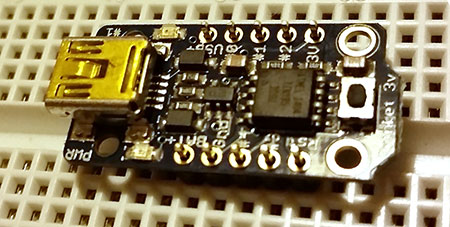Electrons: Adding header pins to the Trinket
Making connections easier
So far I have powered and programmed my Trinket by plugging in a usb cable to the onboard socket. The idea of this board though is that you program in then power it by other means. As supplied the board is flat with holes to connect things to as shown above. Also a set of header pins were supplied in the package.

If I was going to use this board for a specific purpose, I would wire things directly to the board. I don't ever intend to build this board it into a final product - so just need an easy way to connect things to it. So on this occasion I will to solder the header pins onto the board so I can then plug it into a breadboard...
A breadboard is a nifty bit of equipment that allows you to temporarily connect components together. It's often used in prototyping circuits - that is - testing if your connections and components work before you put them together in a more permanent manner. It consists of hundreds of little holes which are connected in a specific way.
The one I bought was about £2 delivered from ebay. And has 700 connections:

This isn't the best breadboard I could use but it will do for now and it was cheap. Its also got a lot of room to plug things in. I'll talk more about breadboards in a later post.
So the first job is to solder the header pins onto the Trinket board so it can be pushed into the breadboard. The header pins supplied comes in a long strip, so you cut off the ones that you need. Each side of the Trinket has 5 holes for connections - so I cut two five pin strips from the header using a pair of cutters.

It is better in the long run if these pins are perfectly aligned, so I'm going to help this along by putting the headers in the breadboard to begin with as so:

Now I can make sure all the pins are aligned when I solder them on. The breadboard also holds the job while I'm soldering it.

I wont go into soldering in this post - but here is the finished Trinket with beautifully aligned pins:

Reminds me of the little BEAM robots I used to build. My next post will discuss powering the Trinket for my tinkerings.
18-Nov-2014 Add comment
blog comments powered by Disqus Permanent Link